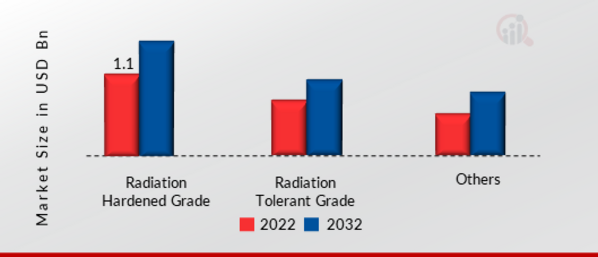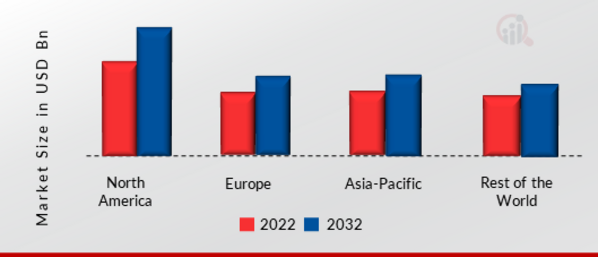Global Space Semiconductor Market Overview
Space Semiconductor Market Size was valued at USD 2.83 Billion in 2024. The Space Semiconductor market industry is projected to grow from USD 3.04 Billion in 2025 to USD 5.68 Billion by 2034, exhibiting a compound annual growth rate (CAGR) of 7.2% during the forecast period (2025 - 2034). Growing interest in wideband gap semiconductors, as well as more money and research being invested in the space sector are the key market drivers accelerating market expansion.

Source: Primary Research, Secondary Research, MRFR Database and Analyst Review
Space Semiconductor Market Trends
-
Growing Enhanced exploration of space is driving the market growth
Market CAGR for space semiconductor is being driven by the rising enhanced exploration of space. Space electronics are defined as electronic components—such as memory chips, controllers, microprocessors, and application-specific integrated circuits (ASICs)—that are created specifically for use in deep space probes, rocket launchers, and satellites. These electronics must have radiation treatment in order to function properly in severe environments since they are subjected to intense vibrations, radiation, and other harsh conditions in space.
Additionally, the space semiconductor market is seeing significant demand driven by the return of space exploration. This resurgence of enthusiasm in space exploration spans a broad spectrum of projects, from bold lunar missions to interplanetary journeys to Mars and beyond. With the launch of these ground-breaking projects by space agencies, commercial enterprises, and international partnerships, there is an unprecedented need for sophisticated space-qualified semiconductor components. One of the main factors propelling the space semiconductor market is the development of scientific equipment, landers, rovers, and spacecraft that are built to resist the harsh environment of space. Modern semiconductor technology is needed for these missions in order to power vital equipment, process enormous volumes of data, and enable connection with Earth.
The materials with wideband gaps are renowned for their ability to withstand high temperatures. They are able to function in a wide variety of temperatures, from the intense heat produced during reentry into Earth's atmosphere to the bitter cold of deep space. Because of the severe temperature swings in space equipment, this thermal resilience is essential for semiconductors. Wideband gap semiconductors are also more energy-efficient, which enables lower power consumption and longer mission durations—an important factor for long-term space missions to far-off planets or interstellar exploration. Wideband gap semiconductor materials are becoming more and more acceptable in the space sector, which gives semiconductor makers more chances to create and offer these cutting-edge parts.
For instance, 22 additional of SpaceX's Starlink internet satellites were put into orbit in September 2023, and the rocket that returned was successfully landed on a ship in the ocean. Furthermore, the success of these commercial endeavors greatly depends on semiconductor components that meet space requirements. The requirement for cutting-edge semiconductor technologies will only grow as space exploration advances and reaches farther into space. Thus, result in driving the Space Semiconductor market revenue.
Space Semiconductor Market Segment Insights
Space Semiconductor Type Insights
The Space Semiconductor Market segmentation, based on type includes Radiation Hardened Grade, Radiation Tolerant Grade, and Others. The radiation hardened grade segment dominated the market. The primary goal of these semiconductors is to tolerate high doses of ionizing radiation, which is a prevalent problem in the space environment. For mission-critical systems and applications, where dependability and resistance to mistakes caused by radiation are crucial, it is essential.
Figure1: Space Semiconductor Market, by Type, 2022&2032 (USD Billion)

Source: Primary Research, Secondary Research, MRFR Database and Analyst Review
Space Semiconductor Component Insights
The Space Semiconductor Market segmentation, based on Component, includes Integrated Circuits, Discrete semiconductors Devices, Optical Device, Microprocessor, Memory, Sensors, and Others. The integrated circuits category generated the most income. Microcontrollers, mixed-signal ICs, analog circuits, and digital signal processors (DSPs) are examples of integrated circuits. In satellites and spacecraft, they supply crucial functions for communication, control, and data processing.
Space Semiconductor Application Insights
The Space Semiconductor Market segmentation, based on Application includes Satellite, Launch Vehicles, Deep Space Probe, and Rovers and Landers. The satellite segment dominated the market. Satellites provide a range of space uses, such as research, communication, Earth observation, and navigation (like GPS) satellites. For data processing, communication, power management, and scientific instruments, semiconductors are essential components found in satellites.
Space Semiconductor Regional Insights
By region, the study provides the market insights into North America, Europe, Asia-Pacific and Rest of the World. The North American Space Semiconductor market area will dominate this market; this can be attributed to NASA's participation in multiple space-related US missions. Additionally, the existence of commercial space companies like SpaceX has stimulated the local market.
Further, the major countries studied in the market report are The US, German, France, the UK, Canada, Italy, Spain, India, Australia, South Korea, China, Japan, and Brazil.
Figure2: SPACE SEMICONDUCTOR MARKET SHARE BY REGION 2022 (USD Billion)

Source: Primary Research, Secondary Research, MRFR Database and Analyst Review
Europe Space Semiconductor market has the second-largest portion of the market because the European Space Agency is actively involved in creating next-generation space materials and components. Further, the German Space Semiconductor market maintained the most market share, and the UK Space Semiconductor market was the European market with the quickest rate of growth.
The Asia-Pacific Space Semiconductor Market is anticipated to expand between 2023 and 2032 at the quickest CAGR. This is due to the creation of a greater number of electronic components utilizing state-of-the-art manufacturing techniques. Moreover, China’s Space Semiconductor market maintained the most market share, and the Indian Space Semiconductor market was the Asia-Pacific market with the quickest rate of growth.
Space Semiconductor Key Market Players & Competitive Insights
Leading market players are heavily investing in R&D to diversify their product lines, which will support the market's continued expansion for space semiconductors. Additionally, market players are engaging in a range of calculated initiatives to increase their worldwide presence, with important market developments involving the introduction of new products, contracts, M&A transactions, increased investment, and cooperation with other enterprises. To grow and endure in an increasingly cutthroat and dynamic market, Space Semiconductor industry must provide reasonably priced goods.
One of the main business strategies employed by manufacturers is to manufacture locally in order to reduce operating expenses in the global Space Semiconductor industry to help customers and expand the market segment. In recent years, the Space Semiconductor industry has provided some of the biggest benefits to medicine. Major players in the Space Semiconductor market, including Teledyne Technologies Incorporated (U.S.), Infineon Technologies AG (Germany), Texas Instruments Incorporated (U.S.), Microchip Technology Inc. (U.S.), and others, are engaging in research and development activities in an effort to boost market demand.
Teledyne Technologies Incorporated. George Kozmetsky and Henry Singleton launched it as Teledyne, Inc. in 1960. Teledyne, Inc. had possessed more than 150 companies with a range of interests, including insurance, dental appliances, specialty metals, and aircraft electronics, however many of these had been sold off before to the company's merger with Allegheny. 19 companies that had previously been a part of Teledyne, Inc. made up the new Teledyne Technologies at first. In October 2023, Xena Networks is a provider of high-speed terabit ethernet validation, assurance, and production test solutions. Teledyne Technologies purchased them.
Infineon Technologies AG. In 1999, Siemens AG split out the business. Among the top 10 global semiconductor producers, Infineon employs roughly 50,280 people. Infineon sells chip card and security devices in addition to semiconductors and systems for the automotive, industrial, and multimarket industries. Infineon maintains subsidiaries in the Asia-Pacific area, namely Singapore and Tokyo, Japan, as well as in the US in Milpitas, California. In May 2023, Imagimob, a little machine learning startup with a platform for creating and implementing edge AI applications and located in Stockholm, Sweden, was purchased by Infineon.
Key Companies in the Space Semiconductor market include
- Teledyne Technologies Incorporated (U.S.)
- Infineon Technologies AG (Germany)
- Texas Instruments Incorporated (U.S.)
- Microchip Technology Inc. (U.S.)
- Cobham Advanced Electronic Solutions Inc. (U.K.)
- STMicroelectronics International N.V. (Switzerland)
- Solid State Devices Inc. (U.S.)
- Honeywell International Inc. (U.S.)
- Xilinx Inc. (U.S.)
- BAE System Plc (U.K.)
- TE Connectivity (Switzerland)
Space Semiconductor Industry Developments
September 2023: The UK firm Space Forge and Northrop Grumman have inked a strategic agreement. The usage of compound semiconductor substrates that it intends to produce in low earth orbit is supported by the agreement.
June 2023: Airbus Ventures has announced a $7.5 million investment in Zero-Error Systems, a company that provides semiconductor solutions for power management and space applications.
April 2023: Presto Engineering and SatixFy collaborated to test and validate their radiation-hardened ASICs for use in space missions.
Space Semiconductor Market Segmentation
Space Semiconductor Type Outlook
- Radiation Hardened Grade
- Radiation Tolerant Grade
- Others
Space Semiconductor Component Outlook
- Integrated Circuits
- Discrete semiconductors Devices
- Optical Device
- Microprocessor
- Memory
- Sensors
- Others
Space Semiconductor Application Outlook
- Satellite
- Launch Vehicles
- Deep Space Probe
- Rovers and Landers
Space Semiconductor Regional Outlook
- North America
- Europe
- Germany
- France
- UK
- Italy
- Spain
- Rest of Europe
- Asia-Pacific
- China
- Japan
- India
- Australia
- South Korea
- Australia
- Rest of Asia-Pacific
- Rest of the World
- Middle East
- Africa
- Latin America
| Report Attribute/Metric |
Details |
| Market Size 2024 |
USD 2.83 Billion |
| Market Size 2025 |
USD 3.04 Billion |
| Market Size 2034 |
USD 5.68 Billion |
| Compound Annual Growth Rate (CAGR) |
7.2% (2025-2034) |
| Base Year |
2024 |
| Market Forecast Period |
2025-2034 |
| Historical Data |
2020-2023 |
| Market Forecast Units |
Value (USD Billion) |
| Report Coverage |
Revenue Forecast, Market Competitive Landscape, Growth Factors, and Trends |
| Segments Covered |
Type, Component, Application, and Region |
| Geographies Covered |
North America, Europe, AsiaPacific, and the Rest of the World |
| Countries Covered |
The US, German, France, UK, Canada, Italy, Spain, India, Australia, South Korea, China, Japan, and Brazil |
| Key Companies Profiled |
Teledyne Technologies Incorporated (U.S.), Infineon Technologies AG (Germany), Texas Instruments Incorporated (U.S.), Microchip Technology Inc. (U.S.), |
| Key Market Opportunities |
· Growing acceptance of semiconductor material with a wide band gap |
| Key Market Dynamics |
· The demand is further increased by the expansion of commercial space exploration, |
Frequently Asked Questions (FAQ) :
In 2024, the size of the Space Semiconductor Market was estimated to be USD 2.83 billion.
From 2025 to 2034, the global market is expected to expand at a compound annual growth rate (CAGR) of 7.2%.
North America held the most market share worldwide.
The leading companies in the market are Texas Instruments Incorporated (U.S.), Microchip Technology Inc. (U.S.), Infineon Technologies AG (Germany), and Teledyne Technologies Incorporated (U.S.).
The market in 2022 was led by the Radiation Hardened Grade category.
The biggest market share worldwide belonged to integrated circuits.














